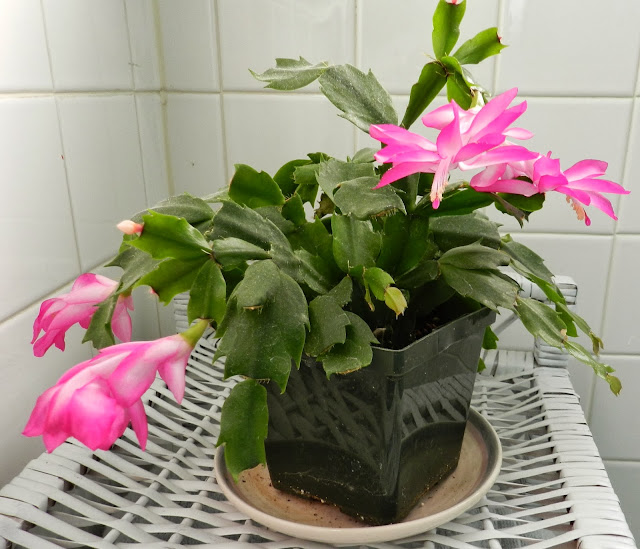It can't be October 15 already! Where has the month gone?? We've had so many warm sunny days since the end of summer that I have been lulled into a sense of complacency that it will last forever. Fall clean-up chores have been put off--it's hard to pull up annuals when they're still blooming. Spring bulbs arrived last week, but my habit of planting bulbs usually involves a biting wind and layers of sweatshirts, not temperatures in the 80's. But the forecast for later this week indicates a change is in the air; it's time for me to stop procrastinating and get serious about gardening once again. It's also means I need to take some time to enjoy the last blooms of the garden while I can.
One of the highlights of the garden this fall has been this Encore Azalea. Both plants,
gifts from Southern Living, have been covered in blooms for the past few weeks. They're still babies, but if they continue to bloom like this as they grow in the coming years, I will be thrilled.
I've often
complained sadly noted that my one Japanese Anemone, planted a few years ago, has never bloomed. Much to my delight, I discovered that I was wrong! Looking more closely at the arbor bed one day, I discovered it was doing just fine, just blooming later than I expected. I'm not sure if this is 'Honorine Jobert' or 'Robustissima,' but I really don't care--I'm just excited to see it finally blooming. One thing I do know, however, is that it's hidden behind some taller plants--some moving around needs to be done so that it can be better appreciated.
The ubiquitous 'Stella D'Oro' lilies have put out a few last gasps. I usually have a couple of re-bloomers in the fall, but this is the only daylily that has re-bloomed this year.
The days are numbered for the annuals, in particular, as a killing frost could come any day now. Most of the containers are looking pretty shabby anyway. I've replenished a few with fall annuals like pansies, kale, and mums, but I'm going to let most of them fade/freeze away so I can clean them out. Say what you will about mums, I like them for their fall color.
The containers that still look the best are the ones filled with coleus. Wish I could remember the name of this one because it's been my favorite with deep magenta leaves that turn almost black in the center. I'm glad I remembered one of the
lessons learned last fall and planted several containers focusing on foliage rather than blooms.
While the coleus are doomed to go with the first frost, the impatiens protected somewhat on the porch wall may last a little longer. I've planted this living wreath with a bargain flat of impatiens for several years now, but it's never done as well as this year. Even though it's looking a bit bedraggled now, it has been full of blooms all summer.
The Hyacinth Bean Vine has a few blooms and its distinctive purple pods, though it never turned into the monster it usually becomes.
While many annuals have seen better days, the lantana is looking even better than earlier in the season. This is my favorite annual for hot, dry summers.
A volunteer petunia, whose origins remain a mystery to me, is still putting out some blooms in the arbor bed.
And of course, there are still zinnias! While cleaning up the roadside garden one day, I got distracted by two Monarchs flitting about. I was so in awe of two Monarchs at once that I completely forgot what I had set out to do. They floated from one flower to another, but always landed on the zinnias--reason enough to plant these old-fashioned favorites.
The arbor bed is full of 'Victoria' Salvias--the 'Blues' were mostly planted from seedlings this spring, but all the 'Victoria Whites' are volunteers. Probably my favorite fall annual--it will take a hard freeze before these pretties finally lose their appeal. And in front of them, of course, is the annual I've bragged about so much this year, the 'Zowie Yellow Flame' zinnias. These have been blooming nonstop--and with very little deadheading from this lazy gardener--since the end of July.
As if you need further motivation to plant these gorgeous zinnias, the butterflies love them. The Red Admirals and a few other butterflies have made a late arrival here, and I'm enjoying them, too, for as long as possible, knowing that it won't be long before they head for warmer climes.
While it's only a matter of time before the frost claims all the annuals, there will still be some color in the garden for awhile. 'October Skies' asters are full of light blue/lavender blooms right now. I don't often show a fuller shot of this late perennial--ignore the weeds, please!--but I wanted you to get the full effect of these mounds of blooms.
Love these blue blooms--and so do the bees!
Another late fall favorite--the Beautyberry--is full of lavender berries.
Late fall is also peak time for the grasses. 'Morning Light' Miscanthus will be waving in the breeze not only after the frost, but all through the winter.
How is your garden doing this fall? Stop by
May Dreams Gardens where our hostess Carol welcomes all to join in this monthly celebration of what is blooming on Garden Bloggers' Bloom Day.






































.jpg)






















